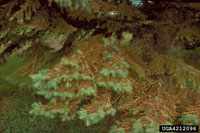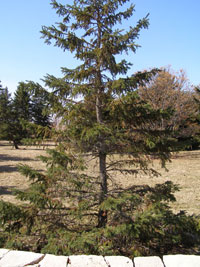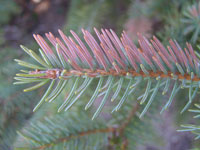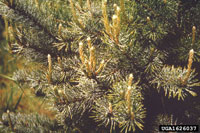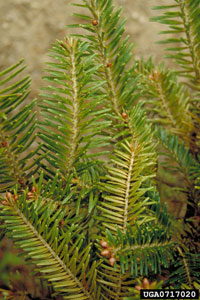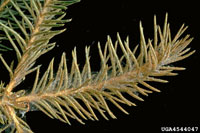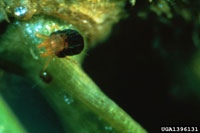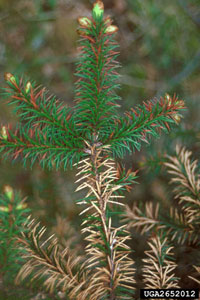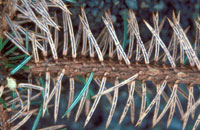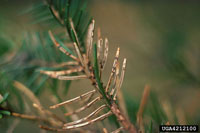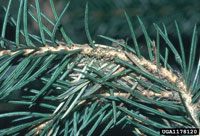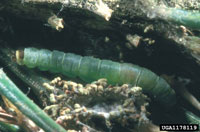Extension > Garden > Diagnose a problem > What's wrong with my plant? > Evergreen Trees and Shrubs > Spruce > Discolored needles
Spruce > Needles > Discolored needles
1 of 7
Rhizosphaera needle cast
Rhizosphaera kalkhoffii
- Infected needles turn brown or purplish brown late in winter or early spring
- Needles at the branch tips remain green, while older needles closer to the trunk of the tree become discolored
- Tiny black dots can be seen with a hand lens on infected needles
- Discolored needles fall off mid summer; tree looks thin and bare
- Damage typically starts on the lower branches and moves up the tree
- Most common on young Colorado blue spruce, but infects all spruces
- More information on Rhizosphaera needle cast
2 of 7
Winter injury
- Needles turn brown or purplish brown in late winter early spring
- Needles turn brown from the tip down, needle base often remains green
- Needles at the tip of the branch are more severely discolored than those close to the trunk
- Damage often only on one side of the tree
- Common in trees exposed to wind and sun, or from light reflecting off buildings
- Damage most severe at the top of the tree, branches covered by snow are unaffected
- More information on Winter injury
3 of 7
Pine needle scale
Chionaspis pinifoliae
- Infested needles are yellowish before turning brown
- Look for small, 1/10th inch white spots on needles, these are adult scales
- Severely infested trees can have sparse needles and branch dieback
- Heavily infested trees can eventually be killed
- More information on Pine needle scale
4 of 7
Spruce spider mite
Oligonychus ununguis
- Needles are mottled yellowish to reddish brown
- Silk can be found between needles
- Most common during spring and fall
- Mites are dark green to brown, 1/50th inch long
- More information on Spruce spider mite
5 of 7
Lirula needle blight
Lirula macroscopa
- In late summer second year needles become discolored, yellow to brown.
- In the following year (third year needles) a raised black line forms along the midrib of infected needles, mostly on the lower surfaces
- In some cases horizontal black bands form across infected needles.
- Needles on lower branches are commonly infected first
- Infected needles turn grayish brown after spores are released but remain attached to tree for several years
- More information on Lirula needle blight
6 of 7
Spruce needle rust
Chrysomyxa spp.
- Needles at the tips of the branches (current year needles) turn yellow
- Pale orange to white tube like projections appear on infected needles in July or Aug and release powdery orange spores
- Severely infected trees may have a tan to pinkish cast
- Infected needles fall off in September
- Some species of rust can cause witches’ brooms, a clump of small weak branches arising from one point on a large branch
- More information on Spruce needle rust
7 of 7
Spruce needle miner
Endothenia albolineana
- Small clusters of brown needles webbed together against branch to form ‘nest’
- Needles hollow with small hole at base
- Larva is brown, gray, reddish and as large as 1/4 inch long
- More information on Spruce needle miner



